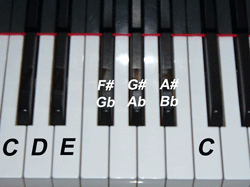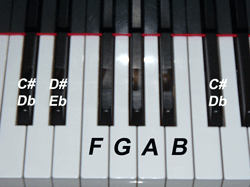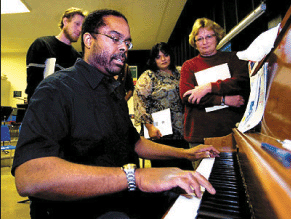In the last lesson, you learned about half-steps, sharps and flats. This lesson focuses on whole steps. A whole step is the distance from one key to the next with one key in between. Or another way of looking at it is a whole step equals two half-steps. For example, if you go from C to D, this is a whole step since there is a key (Db) in between the two.

If we start on C, going up a whole step would be to the note D. The other whole steps are:
- D to E
- E to F#
- F# to G#
- G# to A#
- A# to C
If we go down starting on C, a whole step down would be Bb. The other whole steps are:
- Bb to Ab
- Ab to Gb
- Gb to E
- E to D
- D to C
Remember, the black keys have two names associated with them. We could have easily referred to the black keys by their sharp or flat names.
What you will notice is that when we start on C and go up or down in whole steps, we only cover six keys. As you may recall, there are actually twelve keys in music. So, to cover the other six keys, we will start on C#(Db). Look at the picture below.

If we start on C#(Db) going up a whole step would be to the note D#. The other whole steps are:
- D# to F
- F to G
- G to A
- A to B
- B to C#
If we go down starting on Db(C#), a whole step down would be B. The other whole steps are:
- B to A
- A to G
- G to F
- F to Eb
- Eb to Db
Again, remember that we could have easily called the black keys by their sharp or flat names.
In our next lesson, we will combine whole steps and half-steps to form a major scale.
If you would like to check out all of my podcasts (audio lessons online), click on one of the links below:
- To access with iTunes
- To access with Odeo (odeo/a899ff8db4f63f39)
- to access with Podcast Alley
- direct access to the RSS Feed http://easypiano.com/eppodcast/pianolessons.rss
Charley Wyser
easypiano.com






No comments:
Post a Comment